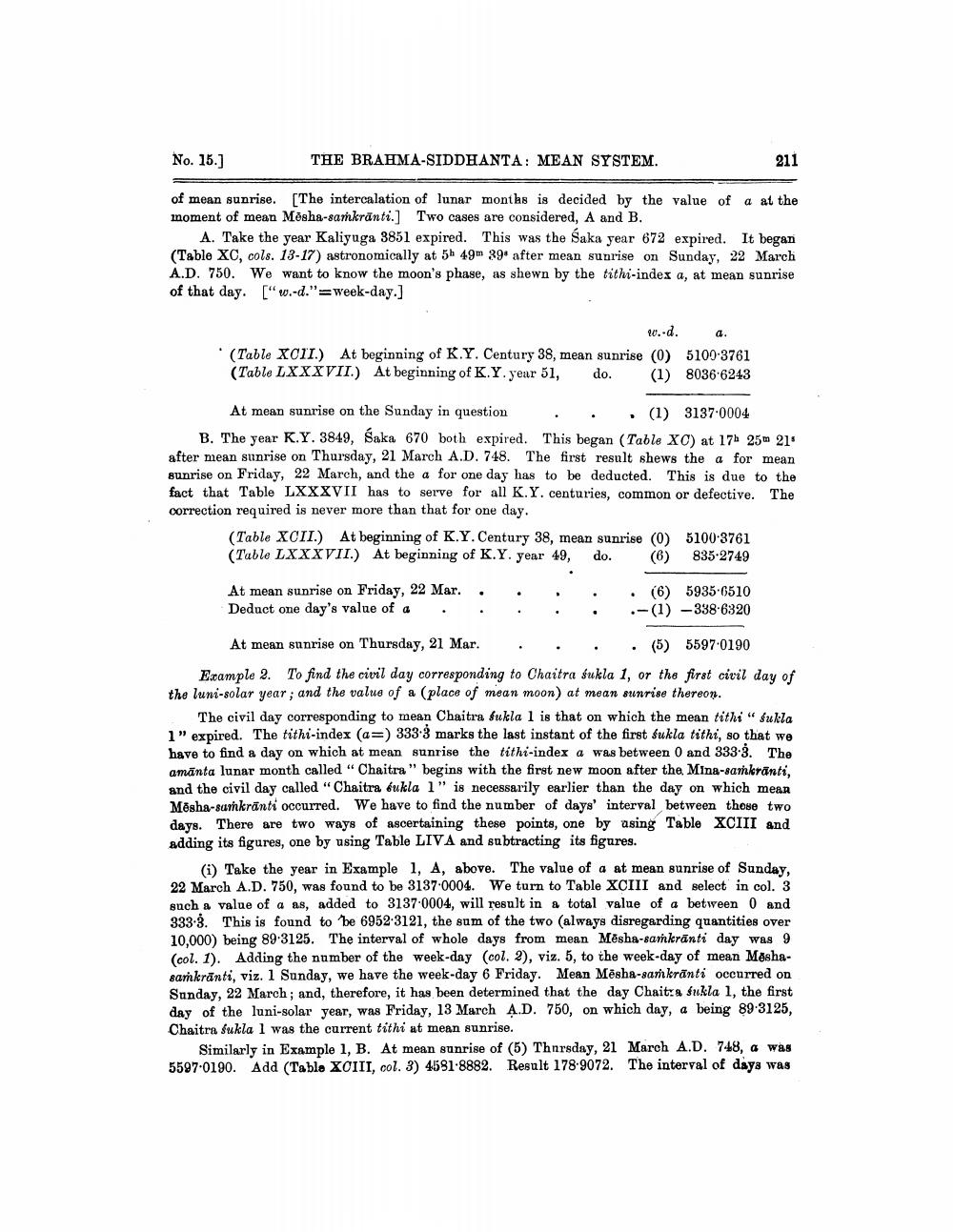________________
No. 15.]
THE BRAHMA-SIDDHANTA: MEAN SYSTEM.
211
of mean sunrise. [The intercalation of lunar months is decided by the value of a at the moment of mean Mosha-saņkrānti.] Two cases are considered, A and B.
A. Take the year Kaliyuga 3851 expired. This was the Saka year 672 expired. It began (Table XC, cols. 13-17) astronomically at 5h 49m 39after mean sunrise on Sunday, 22 March A.D. 750. We want to know the moon's phase, as shewn by the tithi-index a, at mean sunrise of that day. ["w.-d."=week-day.]
W.-d. a. (Table XCII.) At beginning of K.Y. Century 38, mean sunrise (0) 5100-3761 (Table LXXXVII.) At beginning of K.Y.year 51, do. (1) 8036 6243
At mean sunrise on the Sunday in question . . (1) 3137.0004 B. The year K.Y. 3849, Saka 670 both expired. This began (Table XC) at 176 250 21 after mean sunrise on Thursday, 21 March A.D. 748. The first result shews the a for mean sunrise on Friday, 22 March, and the a for one day has to be deducted. This is due to the fact that Table LXXXVII has to serve for all K.Y. centuries, common or defective. The correction required is never more than that for one day.
(Table XCII.) At beginning of K.Y. Century 38, mean sunrise (0) 5100-3761 (Table LXXXVII.) At beginning of K. Y. year 49, do. (6) 835-2749
At mean sunrise on Friday, 22 Mar. . Deduct one day's value of a . .
. .
. .
. .
. (6) 5935 6510 .-(1) -338 6320
At mean sunrise on Thursday, 21 Mar. . . . . (5) 5597.0190 E.cample 2. To find the civil day corresponding to Chaitra sukla 1, or the first civil day of the luni-solar year; and the value of a (place of mean moon) at mean sunrise thereon.
The civil day corresponding to mean Chaitra bukla 1 is that on which the mean tithi" fukla l” expired. The tithi-index (a=) 333 3 marks the last instant of the first sukla tithi, so that we have to find a day on which at mean sunrise the tithi-index a was between 0 and 333-3. The amānta lunar month called "Chaitra" begins with the first new moon after the Mina-samkrānti, and the civil day called "Chaitra bukla 1" is necessarily earlier than the day on which mean Mēsha-sankrānti occurred. We have to find the number of days' interval between these two days. There are two ways of ascertaining these points, one by using Table XCIII and adding its figures, one by using Table LIVA and subtracting its figures.
(i) Take the year in Example 1, A, above. The value of a at mean sunrise of Sunday, 22 March A.D. 750, was found to be 3137.0004. We turn to Table XCIII and select in col. 3 such a value of a as, added to 3137.0004, will result in total value of a between 0 and 333-3. This is found to be 6952 3121, the sum of the two (always disregarding quantities over 10,000) being 89-3125. The interval of whole days from mean Mesha-sankranti day was 9 (col. 1). Adding the number of the week-day (col. 2), viz. 5, to the week-day of mean Mashasarkrānti, viz. 1 Sunday, we have the week-day 6 Friday. Mean Mesha-sankranti occurred on Sunday, 22 March; and, therefore, it has been determined that the day Chaitra sukla 1, the first day of the luni-solar year, was Friday, 13 March A.D. 750, on which day, a being 89-3125, Chaitra Sukla 1 was the current tithi at mean sunrise.
Similarly in Example 1, B. At mean sunrise of (5) Thnrsday, 21 March A.D. 748, a was 5597.0190. Add (Table XCIII, col. 3) 45818882. Result 178.9072. The interval of daya was




